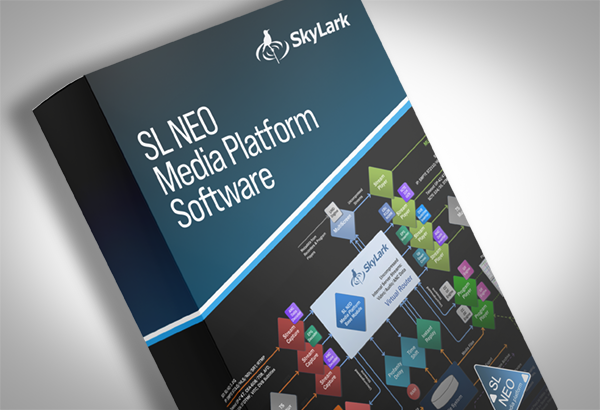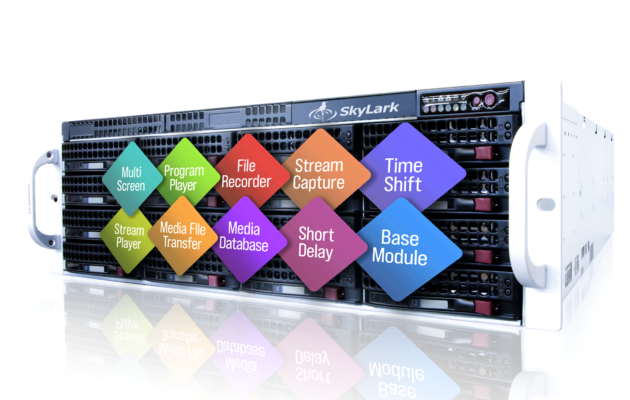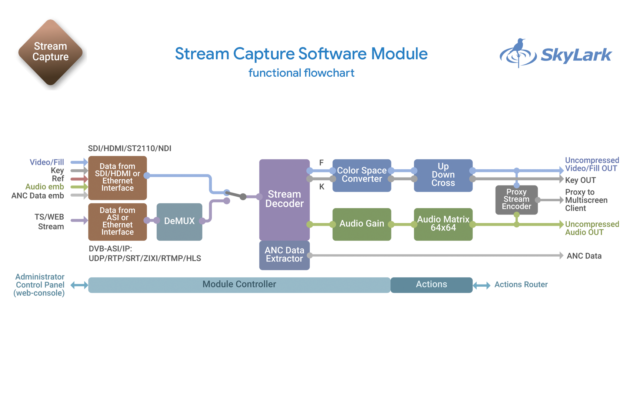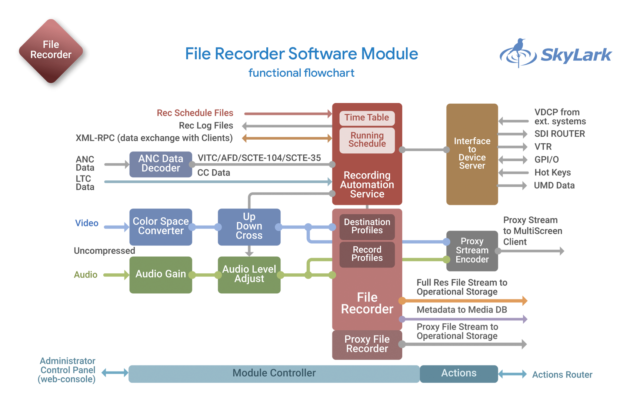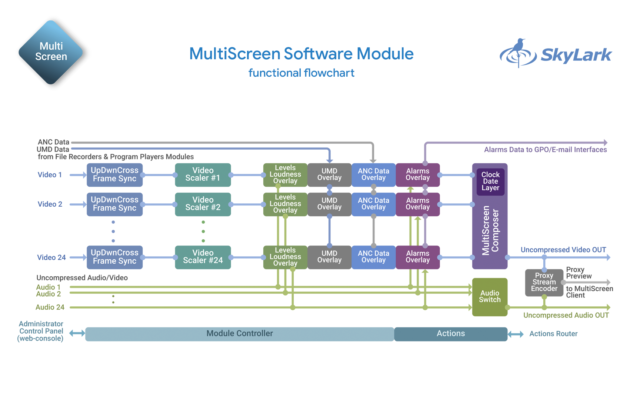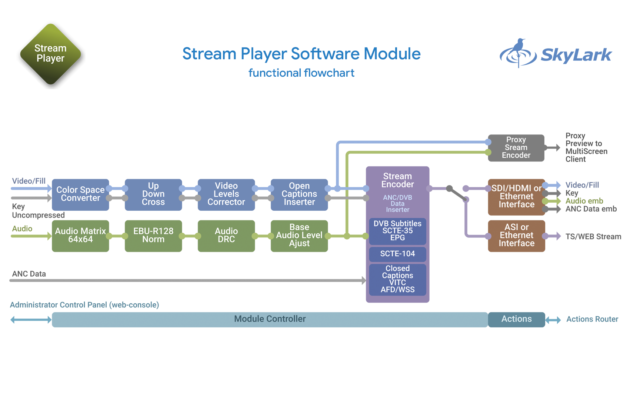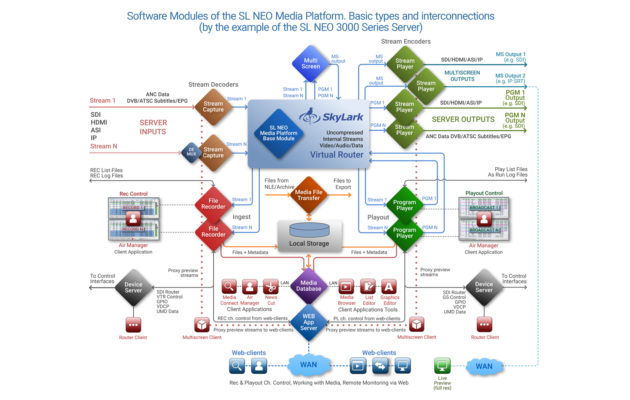To organize the workflow for Media Production or Playout, you need to select the number and types of SL NEO Software Modules by functionality and define the interconnections between them.
A wide range of types of Software Modules supporting all modern technologies, standards and protocols, with flexible and detailed settings, together with client applications and Web-clients, constitute a single universal system for organizing and supporting media workflows: The SL NEO Software Media Platform, developed by SkyLark Technology Inc.
SL NEO Software Modules
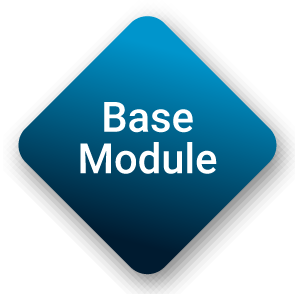
- The Base Module is the Center for Communication and Data exchange between all modules of the Platform.
- Uncompressed audio-video realtime streams with embedded additional data (SCTE tags, Closed Captions, Timecode, etc.) are used for the internal exchange format between Software Modules.
- SL NEO Base Module contains a Virtual Router for internal uncompressed streams, codecs for media files and I/O compressed streams, a Web Server for local or remote Platform configuration via a browser, and other software components that ensure system operation.

- The Command Exchange System between the SL NEO Platform Modules is designed to automate multiple parallel processes during the execution of recording and playback schedules:
— start/stop of secondary events from tokens in the main playlist rows,
— starting/stopping of recording and playback from external commands or from markers,
— generation of control commands and DTMF/SCTE-104/SCTE-35 messages. - The main part of the developed technology is the Action Router module — a functional element of the SL NEO base module.
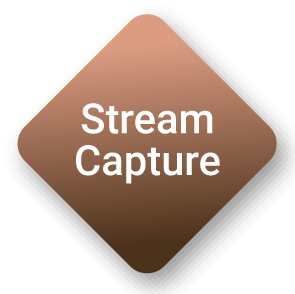
- The Stream Capture Module decodes a single ASI/IP TS/Web stream or receives a SDI/HDMI data from a single port of capture card.
- The module extracts ANC data from the input signal or stream. Contains a built-in MPTS demultiplexer, extracting a single stream from input multiplex.
- The result of decoding is one uncompressed audio/video/data stream for transmission to connected modules (for example, to file recorder) and one proxy stream for visual monitoring over the network.
- The number of active Stream Capture modules determines the number of input ports in the system.
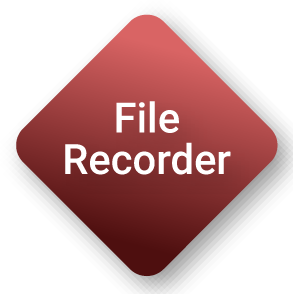
- The File Recorder Module Receives Uncompressed audio/video/data from the connected module, performs encoding according to the selected rec profile (resolution, fps, AV codecs, file container) and writes to files according to the loaded schedule or according to the defined rules.
- The Recorder works together with the SL NEO Media Database and the original metadata is transferred from the recording sheet lines.
- The Fle Recorder makes 2 parallel recordings: full res and proxy, records ANC Data and supports LTC/VITC.
- According to the schedule, the recorder can send commands through the Device Server module to the SDI router to switch signal source and control VTR via Device Server in batch capture mode.
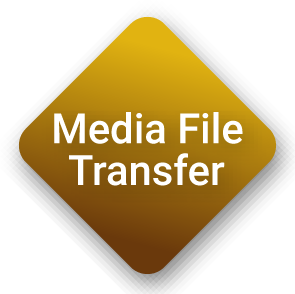
- Transfer Manager Module automatically copies and moves media files between archives, NAS, NLE and ingest/playout servers based on rules. In priority download mode for playout, the executable playlists are analyzed.
- File processing during copying: transcoding (changing resolution, FPS, codec and container), sound level or volume normalization and proxy generation.
- Transfer Manager provides online synchronization of content playout servers SL NEO, the main and backup half sets.
- The module supports up to 8 streams of simultaneous copying with adjustable speed.
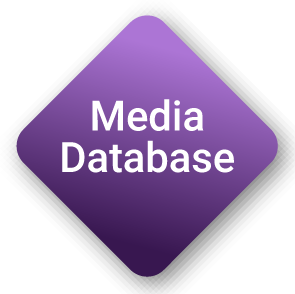
- Media Database significantly expands the functional scope of the operating system when working with media: the user does not work with files but with clips, text metadata enables material search by basic attributes: time, place, event, person, while additional technical profiles, such as proxy, enable collective editing without a significant load on the network.
- The functionality of the module depends on the settings and license type.
- Advanced functionality is designed for media archives of different levels: news service production archive, television company archive.
- Standard feature set (up to 10 metadata fields and up to 10 network connections) is basic for SL NEO Servers.
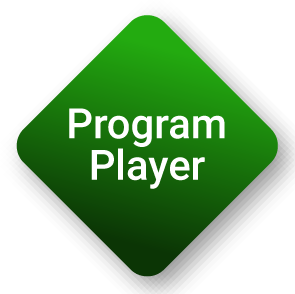
- The Program Player Module acts as a playout automation system for single PGM Channel with layered graphics, branding and external device control.
- The module executes the schedule which contains the «main» and «secondary» events of the graphics. The final PGM video is a composition containing several layers (from bottom to top):
— a full-screen BG layer (e.g., an external Live Feed),
— a full-screen file playback layer overlapping the BG,
— Graphic Layers, which are formed by 8 Title and Graphic Players,
— Logo layer. - The final PGM video/audio is rendered directly during playback.
Graphics players can work autonomously and be controlled manually (e.g., in a production studio). - Module can control external devices — SDI routers via Device Server, as well as external graphics systems (Cyron, Vizrt).
- Program Player generates service data for the Multiscreen module and external multiviewers using TSL/UMD protocols, allows you to display interactive information about the current state of events.

- Program Player receives and processes DTMF and SCTE-104/SCTE-35 data in the signal from the central station. SCTE data in the input signal is received and transmitted by Stream Capture module.
- Program Player starts and stops events with identifiers specified in SCTE metadata. The DTMF and SCTE-104/SCTE-35 generation mode is used to control of regional insertions.
- Tag positions and SCTE metadata are generated by Program Player according to the information specified in the playlist fields.
- Embedding SCTE data into the output signal is performed by the Stream Encoder module.
- Program Player supports generation of CEA-608/708, OP-42/47 Closed Captions in Live or File modes.
- Integration with FAB, Polistream devices allows you to implement Automated Live Captioning for News, Sports and other live programming.
- In File Mode Program Player use text files with markup as sources for Closed Captions. Module also supports Closed Captions and Teletext retransmission mode.
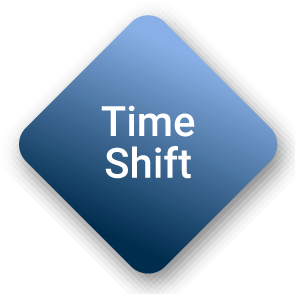
- The Time Shift module performs a simple operation of delaying (shifting) the output signal relative to the input signal from 3 minutes to several hours.
- The disk system of Server acts as a buffer for storage.
- The technology is popular in the United States for belt casting from the east coast to the west coast to different time zones.
- The input and output signals og Time Shift Module are Uncompress Audio/Video.
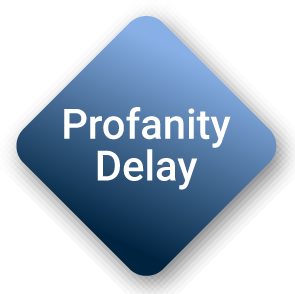
- The Profanity Delay module uses Server memory as a buffer to store data.
- Ideal for preventing any undesirable moments in the Live Broadcast: foul language, obscene gestures, references to competitors or technical problems.
- Typically, a delay time of 7 seconds is a common value in broadcast practice (a feature called Seven Second Delay or Profanity Delay.
- The Module is controlled by buttons on an external USB panel on Client WS, via Hot Keys or by GPI commands from any GPI pushbutton panel.
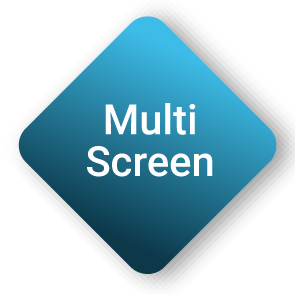
- One module MultiScreen can accept up to 24 input signals and streams of all possible formats and arrange their video sequences in 24 windows of multiscreen composition, with an indication of audio or loudness levels.
- Alarms for freeze frame, black field and audio level deviation from specified values are available.
- A separate window can display the clock and current date.
- Integration with File Recorder and Program Player modules: this allows you to visualize information about playback and recording schedules.
- The uncompressed virtual video/audio stream from the output of the Multiscreen module connected to the input of the Stream Player module via Virtual Router.
- In such a way the additional SDI/HDMI or AS/IP MS output is implemented in SL NEO servers, the same principle is used in Multiscreen Processors SL NEO 8000 series.
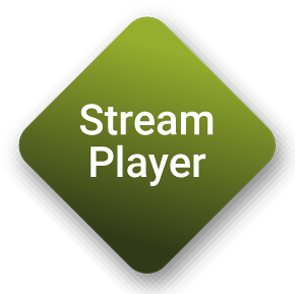
- The Stream Player module encodes and generates one stream of MPEG2/H.264/H.265 via ASI or Ethernet interface.
- The module accepts uncompressed audio/video/data as input, the exchange format between SL NEO modules.
- In SDI/HDMI mode Stream Player provides an interface to the output board, in SDI/NDI modes it can generate FILL and KEY.
- Stream Player module performs signal and data processing operations:
— up/down/cross conversion with changing video frame rate;
— loudness normalization for audio streams in accordance with EBU-R128, audio levels normalization and dynamic range compression;
— DTMF generation, multiplexing into the output stream data of Closed Captions, SCTE-104 or SCTE-35 markers, as well as as EPG, AFD and VITC.
- To generate several streams with different protocols, resolution and FPS parameters several Stream Player modules will be required, according to the number of streams. Uncompressed signals to their inputs may come from the same source via Virtual Router.
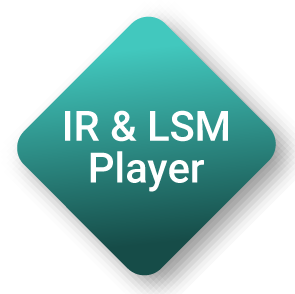
- The IR & LSM Player performs slow-motion playback of recorded fragments, works in conjunction with file recorders.
- It is a basic element of 7000 series slow-motion replay servers. Operator commands instantly switch module to slow-motion playback mode, selects slow-motion input (camera) for replay, and a replay can be programmed.
- Smooth speed control from -200% to +200%, speed change up to single-frame playback.
- Implemented: operational markup and creation of a base of clips, quick editing, assembly and playback of highlight scenes.
- Output signals — Program and Preview with superposition of service information.
- Uncompress Audio/Video format accepted for exchange between the modules of the SL NEO platform.
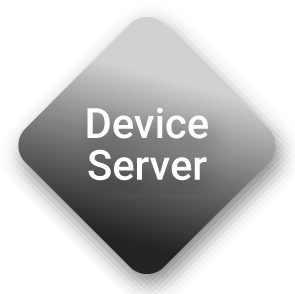
- During rec/playout, Device Server Module receives commands from the File Recorder or Program Player and retransmits them to external devices through software and hardware control interfaces.
- External Devices controlled from the SkyLark SL NEO Recording/Playout System:
— SDI Routers via Serial/Ethernet (Evertz/Leitch/BMD/Snell/Nevion/Grass Valley/Ross and others),
— VTRs with RS-422 (Sony 9-pin Remote Protocol) or IEEE1394,
— GPI/O Devices via USB modules Ontrak,
— Vizrt (direct integration) or Cyron Graphics Stations (CII, Chyron Intelligent Interface),
— Audio Devices (Ember+),
— Multiviewers with TSL5 UMD Protocol.
- SkyLark SL NEO Recording/Playout System in slave mode: The File Recorder and Program Player modules can receive control commands from external Systems via VDCP over IP in slave mode, as well as from external control panels and devices via GPI/O and Hot Keys.
SL NEO Tech Specifications, Supported Devices and Interfaces
| SUPPORTED TELEVISION & MEDIA FORMATS | |
|---|---|
| Video Formats |
SD: 625i, 525i HD: 720p, 1080i, 1080p 2K Cinema: 2048x1080p Ultra HD: 2160p FPS: 25/29,97/50/59.94/60 |
| Color Spaces |
BT.601, BT.709, BT.2020 SMPTE ST2084 ARIB STD-B67 |
| SUPPORTED AUDIO/VIDEO INTERFACES & DATA TYPES | |
| Audio/Video I/O Interfaces |
SDI: SD/HD/3/6/12G SDI or 4x 3G SDI HDMI 1.4/2.0 Audio Embedded DVB/ATSC ASI: SPTS/MPTS DVB/ATSC IP: UDP/RTP Unicast/Multicast SPTS/MPTS IP: SMPTE ST2110, 2022-7 IP: NDI IP: HLS, RTMP, UDP, RTP, SRT, Zixi, RIST, MPEG-DASH |
| Audio/Video Codecs for Streams |
Video: MPEG2/H.264/H.265 Audio: 48kHz, 16 or 24 bit PCM, ADPCM, MPEG-1 L-II/III, AAC, AC3 |
| Audio/Video ANC/MPEG2 Data Embedded |
OP-42/OP-47 WST Teletext and Сlosed Captions CEA-608/CEA-708 Closed Captions SCTE-104/SCTE-35 markers with metadata VBI/VANC Data: VITC, AFD, WSS DTMF Cue Tones EPG/Subtitles Data in MPEG2 TS |
| SUPPORTED AUDIO/VIDEO I/O BOARDS & HARDWARE INTERFACES | |
| SDI/HDMI/ASI I/O Boards (Main Category) |
Dektec DTA-2172 Dektec DTA-2174B Dektec DTA-2175 Dektec DTA-2178 Dektec DTA-2179 Dektec DTA-2195 |
| SDI/HDMI/ASI I/O Boards (Secondary Category) |
AJA Mobile I/O (Thunderbolt) AJA Desktop & Developers I/O (PCIe) Matrox DSX LE3 & LE4 Blackmagic: DeckLink & Intensity |
| ASI/IP I/O Boards & Interfaces |
IP UDP/RTP with SMPTE 2022-1 FEC: Dektec DTA-2160 Dektec DTA-2162 IP SMPTE ST2110/2022-7: Nvidia ConnectX NIC 10/25/40/50/100/200 and 400G Ethernet Network Adapters IP SMPTE ST2110 (Capture Only), NDI HLS, RTMP, UDP, RTP, SRT, Zixi, RIST, MPEG-DASH: Standard Ethernet Interfaces |
| Other Boards & Interfaces |
DataPath Vision RGB Boards i-Link/IEEE 1394 Interfaces DirectShow Devices |
| FILE AUDIO/VIDEO CODECS (INGEST/PLAYBACK/EXPORT) | |
| Video SD/HD |
DV25, DVCPRO25, DVCPRO50, DVCPROHD100, HDV IMX 30/40/50 XDCAM EX SP/HQ XDCAM HD LP/SP/HQ.422 DNxHD 120/145/180/220 AVCHD XAVC 50/100/200 XAVC Long GOP AVC-Ultra 50/100/200 AVC-Ultra Long G (12/25/50) PRORES HQ/SD/LT MPEG-2 I-Frames/Long GOP H.264 L I-Frames/Long GOP |
| Video Ultra HD |
XAVC 300/480 XAVC Long GOP AVC-Ultra 300/480 AVC-Ultra Long G PRORES SQ/HQ DNxHR SQ/HQ H.264 8/10 bit HEVC 8/10 bit |
| Audio |
RAW 16/24 Bit PCM, ADPCM, MPEG-1 L-II/III, AAC, AC3, AC3 passthrough |
| FILE CONTAINERS (INGEST/PLAYBACK/EXPORT) | |
|
MXF-OP1A, MXF-D10 Avid MXF (OP-Atom) Sony XDCAM HD/422 (MXF-OP1A) Sony XAVC 50/100/200/300/480/LongGOP (MXF-OP1A) P2 AVC-Ultra 50/100/200/300/480/LongG (MXF-OP1B) Microsoft AVI, MPEG PS/TS, QuickTime MOV, DV DIFF, MP4, MPG, GXF |
|
| REC ENVIRONMENTS | |
|
OS File System: work with files only, normal or fragment file recording mode (array of files with configured fixed duration), SL NEO Media DataBase: work with Virtual Clips (full res+proxy+metadata), Avid Unity/Interplay |
|
| GRAPHICS FILE FORMATS | |
| Still Graphics |
Single files and sequences: JPG, BMP With Alpha: PNG, TGA, PSD |
| Video with Alpha Codecs |
Uncompressed TGA, QTRLE, Speed HQ, Lagarith, Key from a separate file JPGA codec for AVI |
| Video with Alpha File Containers |
Microsoft AVI QuickTime MOV Audio supported |
| SUPPORTED CONTROL INTERFACES & DATA TYPES | |
| GPI & Tally, LTC Readers |
USB GPIO: Ontrak ADU200, ADU2X8. LTC Readers: Adrienne AEC-41, Plura PLC, Miranda Little Red, Horita TCI-50 |
| Hardware Interfaces |
Standard Ethernet Ports, RS-232/422/485, i-Link/IEEE1394 |
| Other Protocols |
SNMP (SL NEO Server Software Monitoring) NTP/PTP Client SMB/CIFS, FTP |
| INTERACTION WITH EXTERNAL DEVICES & SYSTEMS | |
| REC/PGM Channels Control |
1). From the Input Streams through SL NEO Action Router: SCTE-104/SCTE-35 markers with metadata, VBI/VANC data, DTMF cue tones, Black or Still frames, Matching of images with the recorded samples. 2). Through SL NEO Device Server: VDCP over IP, Hot Keys, GPI. 3). Via XML-RPC and SL NEO Control Protocol. |
| Graphics Playout Control |
1). From the Input Streams through SL NEO Action Router. 2). Through SL NEO Device Server: CII over IP, Hot Keys, GPI. 3). Via XML-RPC and SL NEO Control Protocol. |
| External Device Control from REC Channels |
Through SL NEO Device Server: VTR (use Sony Remote Protocol), SDI Router, TSL5 UMD, GPI & Tally |
| External Device Control from PGM Channels |
1). Through SL NEO Device Server: SDI Routers or Master Control Switchers, Graphics Stations: VizRT, Chyron CII, Junger Audio Devices (Ember+), Multiviewers (TSL5 UMD), GPI & Tally. 2). Through SL NEO Action Router: SCTE-104/SCTE-35 markers with metadata, DTMF cue tones in output Streams. |
| Supported SDI Routers |
Grass Valley Triton BDS Grass Valley Nvision/Native Protocol/Vega/M-2100 Nevion Vikinx v128/Thor Leitch, Kramer BMD Videohub Ethernet/RS-232 Snell Switcher/Remote Protocol Evertz Quartz/QMC-2 Sierra XXvse Utah SC-4/RCP-1 Pro Bel SW-P-02/SW-P-08 Venux VM/SI/3000 ASCII Ross Video Presmaster/NK-SCP/A ELPRO SDZHD Series AJA KUMO Imagine LRC LES, Profit |
